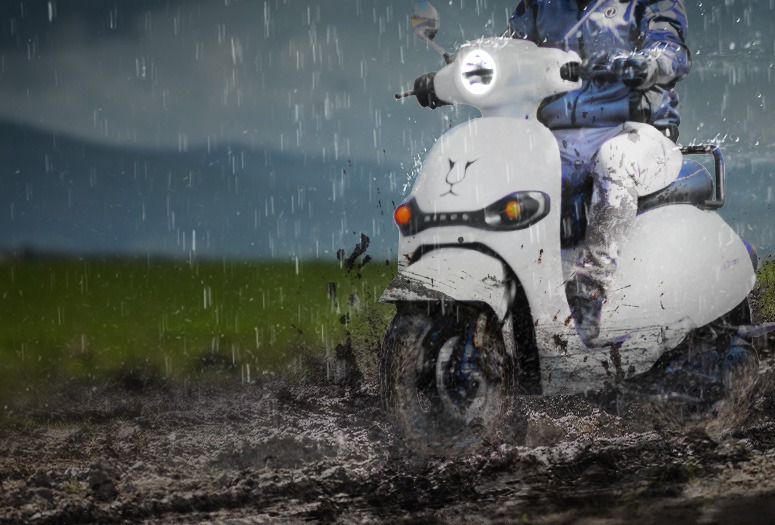To ride electric scooters in the rain safely, wear waterproof gear and avoid puddles. Ensure your scooter is rated for wet weather use before heading out.
Electric scooters have become a popular mode of transportation in urban settings, providing a quick and eco-friendly way to navigate the streets. With the onset of unpredictable weather, many riders find themselves caught in the rain. Riding an electric scooter during wet conditions requires extra precautions to ensure both your safety and the longevity of your scooter.
The importance of checking the weather-resistance rating of your e-scooter cannot be overstated; only models designed for such conditions should be used. Additionally, wearing appropriate weatherproof clothing and accessories can protect you from the elements. Riding an e-scooter in the rain introduces additional challenges such as slippery surfaces and reduced visibility, which is why adopting a cautious approach and modifying your riding style is imperative. With the right preparation and mindset, you can navigate rainy days confidently and safely on your electric scooter.
Understanding The Risks
Rainy weather poses unique challenges for electric scooter enthusiasts. Riding an electric scooter in the rain is not just about dealing with discomfort, but also confronting a set of risks that can impact your safety and the scooter’s performance. By recognizing the risks involved, you can take proactive measures to ensure a safer ride. Let’s explore the potential hazards associated with wet conditions and how they affect various components of your scooter.
Electric Scooter Components Vulnerable To Rain
Water and electronics don’t mix well, and this principle applies to electric scooters. A number of components can suffer when exposed to water:
- Battery: The battery is the heart of the scooter, and water ingress could lead to short circuits or corrosion.
- Control Panel: The control panel, which typically houses the throttle and display, is susceptible to water damage, potentially affecting your ability to operate the scooter.
- Motors: Motors are generally sealed, but consistent exposure to water can compromise their integrity.
Making sure that these components have proper waterproof ratings, such as IP54 or higher, is essential for durability in wet conditions.
Impact Of Wet Surfaces On Traction And Braking
Rain transforms roads and pathways into slippery hazards. The key dangers include:
| Traction Reduction | Braking Distance Increase |
|---|---|
| Tires have less grip on wet surfaces, leading to a higher risk of skidding. | Braking effectiveness diminishes, resulting in longer distances to come to a halt. |
To combat these issues, reduce speed, use tires suitable for wet conditions, and allow extra space for braking.
Importance Of Visibility In Rainy Conditions
Heavy rain impairs visibility, making it difficult for you to see and for others to see you. The significance of this cannot be overstated:
- Use reflective clothing or accessories to stand out in poor lighting conditions.
- Equip your scooter with lights and reflectors on the front, back, and sides.
- Consider wearing a clear, water-resistant helmet visor to maintain unobstructed vision.
By enhancing visibility, you not only protect yourself but also contribute to the overall safety of the traffic environment.
Preparing Your Electric Scooter
Imagine a rainy day – gray skies above and puddles on the ground, but you’re unfazed because your electric scooter is ready to take on the wet challenge. Adequate preparation of your electric scooter not only ensures a safer ride through the drizzles and downpours but also prolongs the life of your ride. Let’s get into the nitty-gritty of gearing up your scooter for the rain.
Choosing A Water-resistant Electric Scooter Model
Your first shield against the rain starts with the choice of scooter. Always look for models with high IP ratings; these numbers give you an idea of how well the scooter can withstand water exposure. An IP54 rating or higher often indicates that your scooter can handle splashes from all directions. Check the manufacturer’s specifications for this crucial detail before making a purchase.
Waterproofing Essential Components
Even with a water-resistant model, taking extra steps to waterproof the essential components of your electric scooter can save you from potential hazards. Focus on protecting the battery, control panel, and wiring. Silicone sealants can be applied to gaps and seams for enhanced protection. Additionally, use dielectric grease on exposed electrical connectors to prevent corrosion caused by moisture.
Purchasing And Installing Appropriate Rain Gear
Appropriate rain gear further shields your electric scooter and its vital elements from water damage. Consider these additions:
- Tire fenders or mudguards
- Water-resistant covers for the seat and display
- Non-slip handlebar grips to maintain control
Invest in quality rain gear and ensure they are properly installed to maintain visibility and traction during your wet travels. With your electric scooter geared up, you’re just a step away from a rain-ready ride!
Riding Techniques For Rainy Conditions
Embarking on an electric scooter ride in the rain requires more than just a waterproof jacket; it demands specific riding techniques for rainy conditions to ensure your safety. Slippery surfaces, reduced visibility, and longer braking distances are among the challenges riders face in wet weather. Adaptation is crucial, and by honing your riding skills to match these challenges, soggy weather won’t dampen your electric scooter adventures. Let’s explore some techniques to help you navigate the rain-drenched streets with confidence.
Adjusting Speed And Braking Distance
Slick roads reduce your tire’s grip, causing longer stopping distances and increasing the risk of skidding. In such conditions, lowering your speed is vital.
- Slow down significantly to maintain control.
- Apply brakes gently to prevent locking up the wheels.
- Allow for increased stopping distances. Anticipate stops earlier than you typically would.
- Use both brakes evenly to distribute the force, reducing the likelihood of a skid.
Navigating Puddles And Wet Surfaces
While riding an electric scooter in the rain, you will encounter puddles and wet surfaces that can be deeper or more slippery than they appear. Properly navigating these can prevent accidents.
- Avoid large puddles when possible as they can hide potholes or debris.
- If unavoidable, approach puddles at a reduced speed and keep straight.
- Stay alert for slippery surfaces such as painted road markings or metal covers, as these can become especially slick when wet.
- Keep your ride smooth and avoid sudden turns or maneuvers.
Best Practices For Maintaining Balance In The Rain
Keeping balanced on an electric scooter becomes more challenging in the rain. A few best practices will help ensure you remain upright during your wet commute.
- Stand firmly with both feet on the deck to maximize stability.
- Lean slightly forward while accelerating and backwards when slowing down to distribute your weight effectively.
- Avoid sharp turns and sudden moves that can cause you to lose balance.
- Wear appropriate footwear with a good grip to prevent your feet from slipping off the deck.
Safety Gear For Riding In The Rain
Safety Gear for Riding in the Rain is crucial not only for your comfort but for your protection. As you prepare to ride your electric scooter despite the drizzle or downpour, gearing up properly should be your foremost priority. Appropriate attire and safety accessories make a significant difference in visibility and protect against the heightened risks associated with wet conditions. In this section, we’ll guide you through selecting the essential equipment to ensure a safe riding experience in the rain.
Waterproof Clothing And Footwear
Staying dry while riding your electric scooter in the rain starts with waterproof clothing and footwear. These items are your first line of defense against the elements. Opt for waterproof jackets and trousers crafted from breathable yet impermeable materials. It’s essential to consider:
- Sealed Seams: Ensure the garment is completely sealed at the seams to prevent water ingress.
- Adjustable Closures: Cuffs and collars with adjustable fittings can be tightened to keep rain out.
For footwear, choose water-resistant or waterproof shoes with a non-slip sole.
Importance Of Helmet And Visor In Rainy Conditions
When rain hits, visibility and head protection are paramount. A helmet with a visor is non-negotiable. The correct helmet must be snug yet comfortable, and the visor should be:
- Anti-fog: To maintain clear vision during your ride.
- Scratch-resistant: To endure the additional abrasion from rain and road debris.
Ensure the helmet is up to safety standards and replace it immediately if it ever gets compromised due to a fall or collision.
Additional Safety Equipment For Enhanced Visibility
Poor weather greatly reduces visibility on the road, both for riders and other commuters. Enhanced visibility gear is therefore essential. This includes:
- Reflective Wear: Wearable reflective strips or vests help you stand out in low-light conditions.
- Lighting: Keep your scooter’s lights on and consider additional LED attachments or blinking lights.
Reflective decals can be placed on helmets and even the scooter itself for extra visibility. Always ensure your lights and reflective materials are clean, functional, and properly positioned before each ride.
After-ride Maintenance And Care
Riding your electric scooter in the rain not only takes a toll on your gear but also demands extra attention to maintenance afterward. Proper post-ride care ensures your scooter remains safe and functional for future adventures. Follow these key steps to maintain your electric scooter following a wet journey.
Drying And Cleaning Your Electric Scooter
First and foremost, gently wipe down your electric scooter with a soft cloth to remove any excess water. Focus on areas where water is likely to accumulate, such as under the deck and around the wheels. Once the surface moisture is removed, proceed to air-dry the scooter in a well-ventilated space away from direct sunlight to prevent damage to the electronic components.
- Clear away debris and dirt that may have stuck to the scooter while riding in the wet conditions.
- Using a dry cloth or towel, thoroughly pat down all surfaces.
- Avoid abrasive materials or harsh chemicals that can harm the scooter’s finish.
Ensuring Battery And Electrical Components Are Dry
Electrical integrity is crucial for the safe operation of your scooter. Post ride, it’s vital to check the battery compartment and electrical connections for moisture. If any moisture is detected, use a dry, soft cloth to gently blot it out. In cases where you cannot easily access certain components, consider using compressed air to blow out water from nooks and crannies. Keep the scooter switched off and refrain from charging until you are certain all components are completely dry.
Checking For Signs Of Water Damage And Addressing Them
After thorough drying, inspect your scooter for any indicators of water damage, such as rust or corrosion, especially on metal parts and electrical contacts. Rust can compromise structural integrity and impede electrical conductivity, negatively impacting performance and safety.
| Component | Signs of Water Damage | Action Required |
|---|---|---|
| Battery | Swelling, leakage, power issues | Consult manufacturer or technician |
| Electrical Connections | Corrosion, discoloration | Clean with isopropyl alcohol & dry |
| Metal Parts | Rust, flaking metal | Apply anti-rust solutions or replace |
If you identify any damage or wear, take prompt action by consulting the manufacturer’s guidelines or seek assistance from a professional technician for repairs or replacement of affected components. Regular maintenance enhances the longevity and reliability of your electric scooter, maximizing your enjoyment and safety on future rainy rides.

Credit: www.joyebike.com
Conclusion
Riding electric scooters in the rain requires attentiveness and caution. Embrace waterproof gear and maintain moderate speeds. Regular checks on tire tread and brakes ensure safety. Remember, visibility is key — use lights and reflective materials. Stay safe and enjoy the ride, rain or shine.

